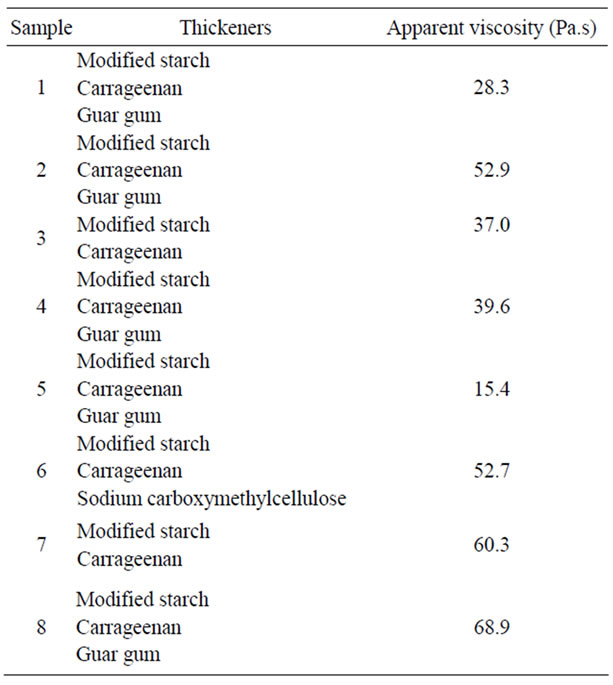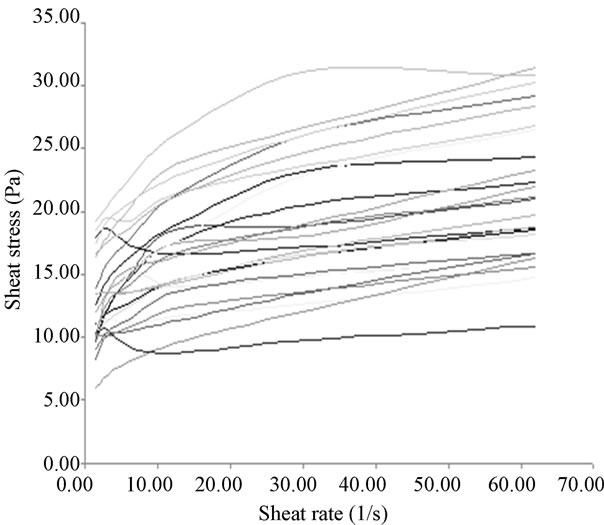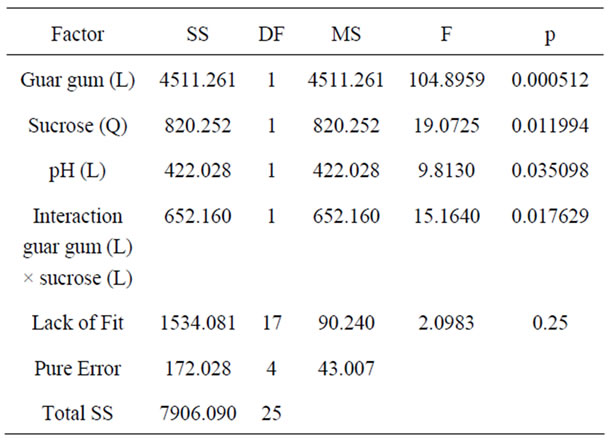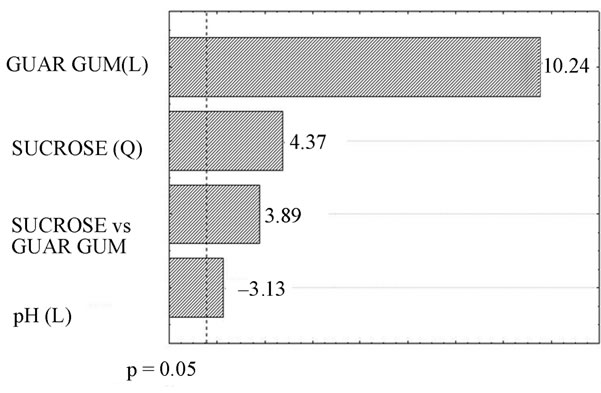Food and Nutrition Sciences
Vol. 2 No. 2 (2011) , Article ID: 4525 , 4 pages DOI:10.4236/fns.2011.22012
Apparent Viscosity of a Skim Milk Based Dessert: Optimization through Response Surface Methodology
![]()
1Graduate Program of Food Technology, Department of Chemical Engineering, Universidade Federal do Paraná, Curitiba, Brazil; 2Department of Botany, Universidade Federal do Paraná, Curitiba, Brazil; 3Department of Biochemistry and Molecular Biology, Universidade Federal do Paraná, Curitiba, Brazil; 4Department of Food Engineering, Universidade Tecnológica Federal do Paraná, Campo Mourão, Brazil; 5Department of Food Technology, Universidade Tecnológica Federal do Paraná, Francisco Beltrão, Brazil.
E-mail: felipereis@ufpr.br
Received January 12th, 2011; revised February 1st, 2011; accepted February 15th, 2011.
Keywords: Viscosity, Milk, Guar, Carrageenan, Dairy Dessert
ABSTRACT
In this study, the apparent viscosity of a skim milk based dessert was optimized through the use of a 5-level Central Composite Design. The effect of carrageenan, guar gum, sucrose and pH on the dessert’s apparent viscosity was estimated. The dessert’s flow behavior was also analyzed. A rotational viscometer was used for the apparent viscosity measurements. All formulations presented a non-Newtonian, shear-thinning behavior. Except for carrageenan concentration, all of the design factors affected apparent viscosity, being the effects better described by second order polynomial models. The following combinations of the variable ingredients yielded the best apparent viscosity: guar gum concentration: 0.0% - 0.315% (w/w) and sucrose concentration: 5.000% - 8.615% (w/w); or guar gum concentration: 0.109% - 0.315% (w/w) and sucrose concentration: 5.000% - 11.000% (w/w); in both cases, carrageenan and pH were kept at 0.020% (w/w) and 6.50, respectively.
1. Introduction
Consumption of foods containing saturated fat is considered to contribute to the development of heart diseases and colon cancer [1,2]. In addition, reduction in the release of flavors, a severe technological limitation, has been associated with the presence of high fat contents in foods such as ice creams and custards, which are semi-solid, typically whole or semi-skimmed milk dairy desserts [3-5]. Therefore, new food systems presenting lower saturated fat content have been proposed [6-8]. Semi-solid dairy desserts are foods with high sensory appeal, usually containing fat milk, thickeners, sucrose and a flavoring agent [9,10].
Recent studies have investigated the rheological behavior of combinations of semi-solid polysac-charide mixtures and dairy products. For example, the addition of λ- carrageenan resulted in an increment in viscosity of semi-solid dairy desserts, and, most of the resulting products presented a clear gel-like behavior [11].
Creaminess, a sensory feature also known as creamy mouthfeel, is a very important attribute of semi-solid dairy desserts [12]. And, for model caramel creams containing various levels of dairy fat and xanthan gum, a positive quadratic relationship between creaminess and apparent viscosity was demonstrated [13]. In addition, in starch-based custard desserts, creaminess has been demonstrated to be determined by its lubricant properties, homogeneity and apparent viscosity [14]. Furthermore, a sensory panel aimed at evaluating butter-in-water emulsions confirmed that apparent viscosity strongly influences the consumer perception of creaminess. When seen together, data from rheological and sensory analysis suggest that the viscosity of the continuous phase is the dominating attribute controlling the perceived creaminess [15]. These findings demonstrated that rheological parameters might be useful for initial screening of custards for better texture [16].
In this work, we describe the use of response surface methodology to optimize the apparent viscosity of a semi-solid skim milk-based dessert, aiming to improve creaminess, a key-sensory attribute of dairy desserts.
2. Materials and Methods
2.1. Materials
The following ingredients were used for the preparation of the semi-solid dairy dessert: UHT (Ultra High Temperature) skim milk (Parmalat, Carazinho, Brazil); sucrose, (Copersucar, São Paulo, Brazil); cross-linked waxy maize starch (Amysol® 700, Corn Products International, Westchester, IL, USA), κ-carrageenan and guar gum (Doce Aroma Comercial Ltda, São Paulo, Brazil). Citric acid and sodium bicarbonate (Labsynth, Diadema, Brazil) were used for pH adjustment and potassium sorbate (SigmaAldrich, Saint Louis, MO, USA) was used as a food preservative.
2.2. Methods
2.2.1. Dessert Preparation
Carrageenan, guar gum, sucrose, citric acid and sodium bicarbonate (for pH adjustment) were used according to the experimental design, reported below. Modified starch and potassium sorbate concentrations were set, for all formulations, at 3.25% (w/w) and 0.04% (w/w), respectively [11]. After stirring the ingredients until complete homogeneity, citric acid or sodium bicarbonate was added to the mixture in order to reach the desired pH. The formulations were individually pasteurized at 74 ± 2˚C for 15 s. Then, the desserts were stored at 4 ± 1˚C, for six hours, before the apparent viscosity measurements.
2.2.2. Apparent Viscosity Measurements
The apparent viscosity of the desserts was measured at 4 ± 1˚C through the use of a rotational viscometer (DV II + LV, Brookfield, Middleboro, MA, USA), equipped with a LV4 spindle. Measurements were carried out at fourteen angular speeds of the viscometer spindle, ranging from 1.5 to 100.0 rpm.
The angular speeds of 2.5, 5.0, 10.0, 20.0, 50.0 and 100.0 rpm were used together with the correspondent apparent viscosity measurements in order to generate the values of shear rate, shear stress and flow behavior index of the formulations. A fixed volume (300 mL) of each sample was used for the apparent viscosity measurements in a 600 mL beaker [17].
2.2.3. Experimental Design
A four factors-five levels response surface Central Composite Design, which resulted in twenty six formulations, was used in this trial. The response surface methodology was chosen in order to optimize the levels of the independent variables (factors) that provided the desired values for the dependent variable (response) [18]. The chosen factors were carrageenan, guar gum and sucrose concentration, and pH. The levels of the factors were chosen according to the recommendations of the manufacturers, in the case of the two gums, and according to previously reported studies on dairy desserts, in the case of sucrose and pH [19,11,4]. The average apparent viscosity found in this study for regular (whole or semi-skimmed milk-based) commercially available semi-solid dairy desserts (Table 2) was used as a target to be achieved for our dairy dessert. Table 1 shows the five levels chosen for each of the four independent variables of the Central Composite Design.
The effect of the factors used in this work on the apparent viscosity were fitted by polynomial models. In order to describe the effects of the several factors on the apparent viscosity, response surfaces were developed

Table 1. Description of the factors used in this work, along with their respective levels.

Table 2. Apparent viscosity and thickeners used in commercial samples used as a reference for the optimization of the apparent viscosity of the formulated dessert.
considering two of the independent variables constant at the central level of the central composite design. The generated mathematical model was submitted to analysis of variance and effects estimation using a 5% confidence level (Statistica version 7.0, Statsoft, Tulsa, OK, USA).
3. Results and Discussion
The apparent viscosities of eight commercially available semi-solid dairy desserts and their respective thickening agents were evaluated (Table 2). The apparent viscosity of these desserts ranged from 15.4 to 68.9 Pa.s, with an average of 44.4 ± 17.6 Pa.s. This average value was used as target for apparent viscosity for our dessert. Five out of eight of the commercially available semi-solid dairy desserts evaluated were gelified/thickened by a combination of modified starch, carrageenan and guar gum. The addition of modified starches to semi-solid foods, in combination with other types of thickeners, has been widely used because the enzymatic breakdown of starch by salivary amylase has been demonstrated to reduce creaminess of semi-solid foods [20,12]. Guar gum is a cheap, broadly used source of food thickener. It consists of a commercial hydrophilic polymer, structurally described as l-4-linked β-D-mannopyranosyl backbone partially substituted at O-6 with α-D-galactopyranosyl side groups, obtained from seeds of Cyamopsis tetragonolobus L. Taub. Guar gum is essentially a galactomannan with a mannose/galactose ratio of 1.6:1 [21]. Carrageenan, another hydrocolloid, is typically used as a thickener in dairy desserts, in combination with starch. Carrageenan consists of a linear sulphated polysaccharide, namely O-β-D-galactopyranosyl-4-sulfate-(1-4)-O3,6-anhydro-α-D-galactopyranosyl-(1-3), obtained from red seaweeds [9,11,4,5]. Upon heating and subsequent cooling, κ-carrageenan forms thermoreversible gels in the presence of gel-promoting cations [22]. In dairy desserts, κ-carrageenans complex with κ-casein micelles of milk generating a thickening effect of 5 to 10 times greater than its effect in water. Carrageenan is a good substitute for fat in dairy products, once it maintains softness in these food systems [23,24].
Figure 1 shows the relationship between the calculated shear rate and shear stress for the twenty six desserts formulated in this work. All of the formulations prepared in this trial presented behavior typical of non-Newtonian fluids, i.e., the relationship between shear rate and shear stress was not linear [25]. This finding agrees with previously reported studies in which whey-enriched [26] and semi-solid [27] dairy desserts showed features of non-Newtonian fluids. In addition, our desserts presented a shear-thinning or pseudoplastic nature, as it had been previously observed for corn starch-galactomannan combinations, where the observed pseudoplasticity was at

Figure 1. Shear rate versus shear stress for the 26 formulated desserts.
tributed to the waxy nature of the employed starch [28]. Recently, the apparent viscosity of combinations of starch and fenugreek, another source of galactomannan, was also shown to present shear-thinning behavior [29].
In this work, the response surface methodology was used to predict the effects of the four studied factors, namely carrageenan, guar gum and sucrose concentrations, and pH on the apparent viscosity of the skim milk dessert. The general form of the second-order mathematical model that provided the best fit, based on the R2 value, was

where Y is the dependent variable; β0 is a constant value; X1, X2, X3 and X4 represent the levels of the factors; β1-β14 represent the estimated coefficients; and ε is a random error. The model was associated with an R2 of 0.784. The best fit for the influence of the factors on the response was observed for the apparent viscosity measured at the angular speed of the viscometer spindle of 4 rpm. Analysis of variance for the model is shown on Table 3. Except for the carrageenan concentration, all of the factors investigated were found to be significant at p = 0.05, i.e., guar gum and sucrose concentration and pH, all affected the apparent viscosity of the dessert.
Figure 2 shows the estimates for the effects of the carrageenan, guar gum and sucrose conce-trations, and pH on the apparent viscosity of the skim milk dessert, according to the mathematical model. The positive, linear relationship found for the apparent viscosity and guar

Table 3. Analysis of variance for the model used to describe the effect of carrageenan, guar gum and sucrose concentrations, and pH on the apparent viscosity of the skim milk dessert.

Figure 2. Pareto chart for the influence of carrageenan, guar gum and sucrose concentrations, and pH on the apparent viscosity of the skim milk based desserts.
gum concentration is likely due to the thickening capacity of the guar and also to the significant influence of the guar gum on the pasting properties of corn starch [28]. The negative relationship found for apparent viscosity and pH in this work is similar to what has been previously reported for modified starch pastes, where the apparent viscosity can be controlled by changing pH [23]. A decrease in pH has been reported to increase the initial stiffness (G’ at 1 Hz) in β-lactoglobulin/κ-carrageenan mixed gels, and initial stiffness has been shown to be positively correlated with creaminess in commercial custards [30,12].
Figure 3 shows the response surface of the apparent viscosity values as influenced by guar gum and sucrose concentrations. The carrageenan concentration and pH were kept at their respective center points (0.02% w/w and 6.50, respectively). Under these conditions, the optimal viscosity range (26.8 to 62.0 Pa.s) is achieved when

Figure 3. Effects of guar gum and sucrose concentration on the apparent viscosity of the skim milk based desserts.
guar gum is used at concentrations between 0.0 and 0.315% (w/w) in combination with sucrose at concentrations within the 5.000 to 8.615% (w/w) range. The same figure shows that adding guar gum at concentrations between 0.109% - 0.315% (w/w) and sucrose ranging from 5.000 to 11.000% (w/w) also yields optimal apparent viscosity. Even though the presence of guar gum, a low cost food additive [23], in the formulation is not a requirement to achieve the optimal viscosity, its incorporation into starch pastes causes a synergistic increase in viscosity [28], improving creaminess in the dessert.
4. Conclusions
Data in this work demonstrate that the response surface methodology can be effectively used to optimize the apparent viscosity of formulated semi-solid skim milk-based desserts through the management of the carrageenan, guar gum and sucrose concentrations, along with the pH of the desserts. According to the fitted mathematical model, the optimal apparent viscosity range found for commercially available semi-solid dairy desserts (26.8 to 62.0 Pa.s) can be achieved in our formulated dessert when: guar gum is used at the 0.0 to 0.315% (w/w) range; sucrose is used at the 5.000 to 8.615% w/w range; carrageenan is used at a concentration of 0.02% (w/w) and pH is 6.50. In addition, the optimal apparent viscosity can also be achieved when: guar gum is used at the 0.109 and 0.315% (w/w) range; sucrose is used at the 5.000 to 11.000% (w/w) range; carrageenan at 0.02% (w/w) and pH at 6.50.
Our results demonstrate that it is possible to produce a healthier dairy dessert without jeopardize creaminess, an important sensory attribute of dairy desserts. Further studies are under way in order to provide a proper flavor to the various possible formulations for the skim milk dessert described in this report and also to analyze their sensory features.
5. Acknowledgements
We would like to thank the Brazilian Government (CAPES) for providing a fellowship to the senior author and to Corn Products International and Doce Aroma Ltda for providing part of the ingredients used in this work.
REFERENCES
- F. B. Hu, J. E. Manson and W. C. Willett, “Types of Dietary Fat and Risk of Coronary Heart Disease: A Critical Review,” Journal of the American College of Nutrition, Vol. 20, No. 1, 2001, pp. 5-19.
- World Cancer Research Fund/American Institute for Cancer Research, “Food, Nutrition, Physical Activity, and the Prevention of Cancer: A Global Perspective,” AICR, 2007.
- E. A. Prindiville, R. T. Marshall and H. Heymann, “Effect of Milk Fat on the Sensory Properties of Chocolate Ice Cream,” Journal of Dairy Science, Vol. 82, No. 7, 1999, pp. 1425-1432. doi:10.3168/jds.S0022-0302(99)75369-5
- M. Keršienė, A. Adams, A. Dubra, N. de Kimpe and D. Leskauskaitė, “Interactions between Flavour Release and Rheological Properties in Model Custard Desserts: Effect of Starch Concentration and Milk Fat,” Food Chemistry, Vol. 108, 2008, pp. 1183-1191. doi:10.1016/j.foodchem.2007.11.011
- M. Martuscelli, G. Savary, P. Pittia and N. Cayot, “Vapour Partition of Aroma Compounds in Strawberry Flavored Custard Cream and Effect of Fat Content,” Food Chemistry, Vol. 108, No. 4, 2008, pp. 1200-1207. doi:10.1016/j.foodchem.2007.05.083
- J. U. McGregor and C. H. White, “Optimizing Ultrafiltration Parameters for the Development of a Lowfat Cheddar Cheese,” Journal of Dairy Science, Vol. 73, No. 2, 1990, pp. 314-318. doi:10.3168/jds.S0022-0302(90)78675-4
- W. L. Kerr, X. Wang and S. G. Choi, “Physical and Sensory Characteristics of Low-Fat Italian Sausage Prepared with Hydrated Oat,” Journal of Food Quality, Vol. 28, No. 1, 2005, pp. 62-77. doi:10.1111/j.1745-4557.2005.00010.x
- F. R. Reis, M. L. Masson and N. Waszczynskyj, “Influence of a Blanching Pretreatment on Color, Oil Uptake and Water Activity of Potato Sticks, and Its Optimization,” Journal of Food Process Engineering, Vol. 31, No. 6, 2008, pp. 833-852. doi:10.1111/j.1745-4530.2007.00193.x
- G. A. El-Garawany and M. H. Abd el Salam, “Preparation and Rheological Properties of a Dairy Dessert Based on Whey Protein/Potato Starch,” Food Chemistry, Vol. 91, No. 3, 2005, pp. 261-267. doi:10.1016/j.foodchem.2004.01.073
- A.-M. Seuvre, C. Turci and A. Voilley, “Effect of the Temperature on the Release of Aroma Compounds and on the Rheological Behaviour of Model Dairy Custard,” Food Chemistry, Vol. 108, No. 4, 2008, pp. 1176-1182. doi:10.1016/j.foodchem.2007.04.031
- A. Tárrega and E. Costell, “Effect of Composition on the Rheological Behaviour and Sensory Properties of Semisolid Dairy Dessert,” Food Hydrocolloids, Vol. 20, No. 6, 2006, pp. 914-922.
- R. A. de Wijk, M. E. J. Terpstra, A .M. Janssen and J. F. Prinz, “Perceived Creaminess of Semi-solid Foods,” Trends in Food Science and Technology, Vol. 17, No. 8, 2006, pp. 412-422. doi:10.1016/j.tifs.2006.02.005
- N. Daget, M. Joerg and M. Bourne, “Creamy Perception I: in Model Dessert Creams,” Journal of Texture Studies, Vol. 18, No. 4, 1987, pp. 367-388. doi:10.1111/j.1745-4603.1987.tb00913.x
- R. A. de WIJK, J. F. Prinz and A. M. Janssen, “Explaining Perceived Oral Texture of Starch-based Custard Desserts from Standard and Novel Instrumental Tests,” Food Hydrocolloids, Vol. 20, No. 1, 2006, pp. 24-34.
- M. Akhtar, J. Stenzel, B. S. Murray and E. Dickinson, “Factors Affecting the Perception of Creaminess of Oilin-water Emulsions,” Food Hydrocolloids, Vol. 19, 2005, pp. 521-526. doi:10.1016/j.foodhyd.2004.10.017
- R. H. Jellema, A. M. Janssen, M. E. J. Terpstra, R. A. de Wijk and A. K. Smilde, “Relating the Sensory Sensation ‘Creamy Mouthfeel’ in Custards to Rheological Measurements,” Journal of Chemometrics, Vol. 19, No. 3, 2005, pp. 191-200. doi:10.1002/cem.922
- P. Mitschka, “Simple Conversion of Brookfield R.V.T. Readings into Viscosity Functions,” Rheologica Acta, Vol. 21, No. 2, 1982, pp. 207-209. doi:10.1007/BF01736420
- NIST/SEMATECH, “What are the objectives”, 2003. Internet Available:
- http://www.itl.nist.gov/div898/handbook/pri/section3/pri31.htm.
- P. H. L. Nikaedo, F. F. Amaral and A. L. B. Penna, “Technological Characterization of Creamy Chocolate Dairy Desserts Prepared with Whey Protein Concentrate and a Mixture of Carrageenan and Guar Gum,” Brazilian Journal of Pharmaceutical Sciences, Vol. 40, 2004, pp. 397-404.
- R. A. de Wijk, J. F. Prinz, L. Engelen and H. Weenen, “The Role of Alfa-amylase in Oral Texture Perception,” Physiology & Behavior, Vol. 83, 2004, pp. 81-91.
- C. M. Dea, and A. Morrison, “Chemistry and Interaction of Seed Galactomannans,” Advances in Carbohydrate Chemistry and Biochemistry, Vol. 31, 1975, pp. 241-312. doi:10.1016/S0065-2318(08)60298-X
- F. Depypere, D. Verbeken, J. D. Torres and K. Dewettinck, “Rheological Properties of Dairy Desserts Prepared in an Indirect UHT Pilot Plant,” Journal of Food Engineering, Vol. 91, No. 1, 2009, pp. 140-145. doi:10.1016/j.jfoodeng.2008.08.017
- N. Bemiller and R. L. Whistler, “Carbohydrates,” In: O. R. Fennema, Ed., Food Chemistry, Marcel Dekker, New York, 1996, pp. 157-225.
- H. Weenen, R. H. Jellema and R. A. de Wijk, “Sensory Sub-attributes of Creamy Mouthfeel in Commercial Mayonnaises, Custard Desserts and Sauces,” Food Quality and Preference, Vol. 16, 2005, pp. 163-170. doi:10.1016/j.foodqual.2004.04.008
- J. F. Steffe, “Rheological Methods in Food Process Engineering,” Freeman Press, 1996.
- S. Mleko and W. Gustaw, “Rheological Changes due to Substitution of Total Milk Proteins by Whey Proteins in Dairy Desserts,” Journal of Food Science and Technology-Mysore, Vol. 39, 2002, pp. 170-172.
- A. Tárrega and E. Costell, “Colour and Consistency of Semisolid Dairy Desserts: Instrumental and Sensory Measurements,” Journal Food Engineering, Vol. 78, No. 2, 2007, pp. 655-661.
- V. Sudhakar, R. S. Singhal and P. R. Kulkarni, “StarchGalactomannan Interactions: Functionality and Rheological Aspects,” Food Chemistry, Vol. 55, No. 3, 1996, pp. 259-264. doi:10.1016/0308-8146(95)00127-1
- G. Ravindran and L. Matia-Merino, “Starch-Fenugreek (Trigonella foenum-graecum L.) Polysaccharide Interactions in Pure and Soup Systems,” Food Hydrocolloids, Vol. 23, No. 3, 2009, pp. 1047-1053. doi:10.1016/j.foodhyd.2008.08.010
- M. O. Eleya and S. L. Turgeon, “The Effects of pH on the Rheology of β-Lactoglobulin/κ-Carrageenan Mixed Gels,” Food Hydrocolloids, Vol. 14, No. 3, 2000, pp. 245-251. doi:10.1016/S0268-005X(99)00055-7

